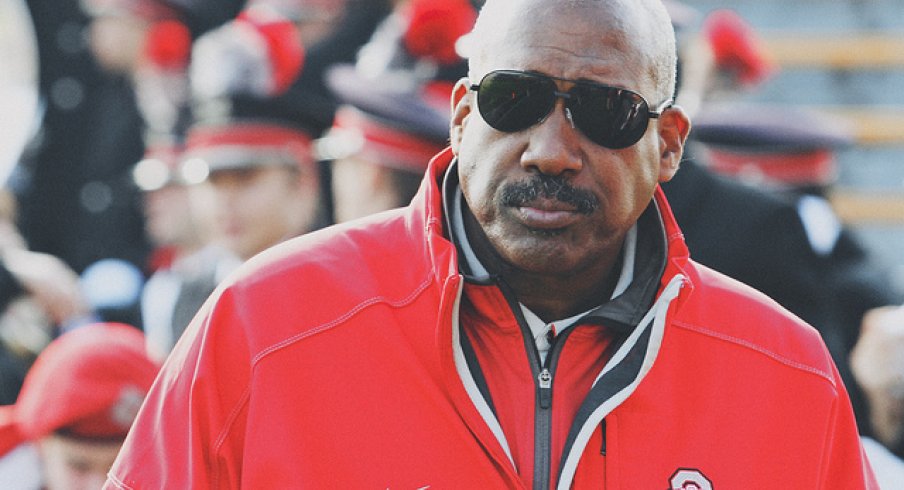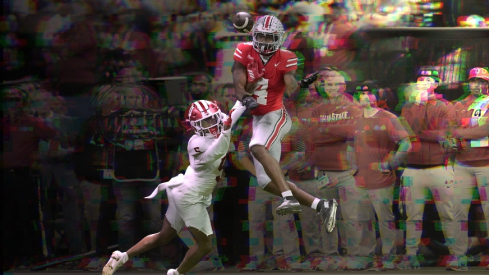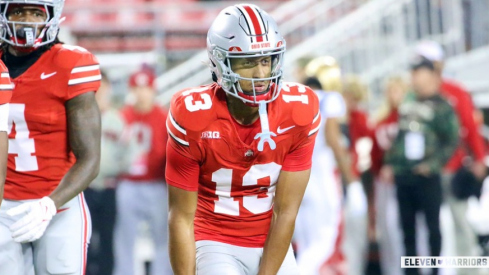From the window that looks out of his 10th floor office at the Fawcett Center, Gene Smith can see most of the buildings that make up Ohio State’s mighty and massive athletic department.
Across the bustle of Olentangy River Rd., for example, is Urban Meyer’s football team at the Woody Hayes Center. South of that, no more than a couple hundred yards away, is Thad Matta’s basketball team at the Schottenstein Center. Speckled throughout this part of campus are the dozens of other sports (baseball, soccer, softball, ice hockey, field hockey, lacrosse etc.) that also call the vast block of land nested next to state route 315 home.
Together, they form the biggest and one of the most lucrative athletic departments in all of college sports. Its stadiums, practice fields and training facilities are a spectacle worthy of that kind of distinction.
And it seems fitting Smith – who’s served as the school’s athletic director for more than nine years – can see so much of it with only a short walk from his desk. From here, way up high on the 10th floor, it all looks so pristine, powerful and peaceful. That’s because it is. Ohio State is one of the nation’s preeminent athletic departments, and that’s not going to change any time soon.
But through a broader scope, the landscape of college athletics remains increasingly turbulent and Smith, who wields as much sway as any administrator in the land, finds himself guiding Ohio State through an unprecedented and revolutionary period. It's unchartered territory and these waters are be choppy.
A brief rundown:
- Last winter, a group of Northwestern football players tried to unionize which, in essence, threatened the sport’s dearly-held model of amateurism.
- It’s partially why it looks imminent that the NCAA will grant autonomy to schools in the Power Five conferences (ACC, Big Ten, Big 12, Pac-12, SEC), which means places like Ohio State should be able to provide its student-athletes with significantly more resources and subsequent opportunities via cost of attendance stipends.
- The O'Bannon trial, an antitrust lawsuit over the NCAA's use of college football and basketball players' names, images and likeness, awaits a resolution.
- Two weeks ago, Big 12 commissioner Bob Bowlsby slammed the NCAA’s toothless enforcement division for enabling a chaotic climate where “cheating pays.”
- Across the nation, schools are fighting a curious decline in student attendance and they’re also battling a culture where it’s as or more enjoyable to watch a game on your big-screen HDTV in your basement compared to sitting inside a crowded stadium.
The point in all this is this: Ohio State, for as stable as it is, isn't immune to any of it.
In an exclusive interview with Eleven Warriors, Smith delves into the biggest challenges facing college athletics and how the school has equipped itself to deal with them.
Finally: Phone-Charging stations in works at the horseshoe
For the first time in the Urban Meyer era, Ohio State sold out – and then some – of its student-ticket allotment in June.
Across the nation, though, there’s been a curious decline of student attendance numbers as part of a larger culture where watching games from the comfort of your home becomes an increasingly popular option.
“We’re trying everything we can to make sure that the experience for the fan in the stadium is as best as it can be compared to your couch and the HD,” he said. “It’s a hard battle, it’s a heck of competitor. It’s a big-time competitor.”
So to ensure it doesn’t become the latest casualty of that trend, the school is in the process of bringing WiFi to Ohio Stadium on game days and “Buckeye-oriented” phone apps to play with.
“All studies show that 25-30 percent of your crowd uses WiFi,” he said. “A lot of people don’t. But what we discussed, that’s a significant number of people. So how do we do that?" Smith expects the process to be finished by the start of the 2015 football season.
In the meantime, it looks like you'll at least have designated places to charge your phone at the Horseshoe this year.
“We’re looking at actually for this year charging stations, trying to have throughout the stadium charging stations for people who want to charge up their phones and all that,” Smith said.
Marching Band Scandal
As first reported by the Columbus Dispatch, Ohio State terminated former marching band director Jon Waters over a “sexualized culture” in late July. It’s also unclear if the band, which gained soaring popularity under Waters’ direction through the last two years, will face additional penalties this upcoming football season.
Smith said he supports President Michael Drake’s decision to fire Waters.
“I wasn’t involved in the process and I really want to be careful with my comments because of the special committee put in place to do an investigation and I’m really not going to comment on it until they finish their investigation,” he said. “But I obviously support President Drake and what he did.
"We have to have a culture of respect, even if some people don’t understand what that means. – Gene Smith
“We have to have a culture of respect, even if some people don’t understand what that means. That’s how we operate our athletic teams and we expect our athletic teams to operate.
"That I support, but I don’t want to get too deep because it’s an ongoing investigation technically with that appointment of that panel.”
Money Matters
After a long and winding road to get there, Smith said he believes the NCAA will grant the Power Five conferences autonomy. It's seismic shift for college sports.
“I think there was a compromise along the way where everybody didn’t get exactly what they wanted but I think for everyone, everybody got enough,” he said.
“The Power Five got what they needed in the areas of autonomy so I think it’s gonna pass and we’ll have to organize to implement so I’m anxious for that.”
After all, it figures to be a massive undertaking. Smith said the conference commissioners are working toward finding candidates to form a council that’ll help govern and guide the transition. Once that’s finished, legislation – like a proposed move for schools to cover cost of attendance – can be entertained.
“The current scholarship model is room, board, books and tuition. That’s what athletes have received over the years,” he said. “Each institution has a formula that determines what additional, miscellaneous expenses you have as a student at your institution that are beyond that room, board, books and tuition.”
Cost of attendance, which would work as additional stipend given to players over a fixated period of time, would cover those expenses.
“You know, it’s cash that allows them to be able to manage their budget a little bit easier. And it’s different at every school. That’s one of the big things that we had to accept – will have to accept – as individual institutions ... I think it just gives some of our kids the ability to stay up to date with their clothing, do some things from an entertainment point of view they may not have historically been able to do. It’s that little extra money.”
Smith said cost of attendance stipends would come to about $3,800 for in-state students and $4,200 for out-of-state students per semester. Full-scholarship student-athletes are also currently provided with $5,804 stipend (or about $800 every other week) per semester once they elect to move off campus. 162 student-athletes, according to Smith, receive Pell Grants worth $5,600 a year.
“Sometimes people don’t know that some of our athletes actually send some of their stipend home to help their families. (Cost of attendance) will alleviate some of that pressure as well,” he said.
“Here’s (what happens) for a lot of athletes that people forget, and you’ll appreciate this, I was one of them: I never grew up aspiring to go to a four-year school. I grew up aspiring to go to a two-year school so I could go work with my dad as an electrician. And all of the sudden, my sophomore year, athletics start to come into my life, I get a couple letters my junior year, I’m like wow. Then my parents start talking to me like you should start thinking about going to college and I’m like, what are you talking about.”
Because the money simply wasn’t there.
“They weren’t developing a college financial war chest for me. So all of the sudden I go to college and I got a scholarship, but I don’t have extra money to do all the other things that all the other kids do,” he said. “Fortunately at that time, we didn’t have all the summer workouts so we could work in the summertime and pad our pockets. But now these kids really don’t have time to have a 40-hour-a-week job in the summertime. It’s different.”
All of the Lights
Ohio State will play in a record five night games next season and host three (Virginia Tech, Cincinnati and Illinois) inside the formidable confines of Ohio Stadium.
Smith said expect to see more games under the lights in the future.
“I think you’ll see more because, actually in our AD meetings this past week or whenever it was, we agreed in the future to be more open in November,” he said.
“Because originally, we were talking about just the first weekend in November. And some of us said, hey we can play the second weekend in November when you really look at it. I think you’ll see a couple more down the road.”
It marks a shift from a Big Ten that’s long been opposed to night games after October for a slew of reasons.
“We really were concerned about the weather and all those types of things. Some of us were concerned operationally. Could we handle it? And I think we’ve grown over the years where operationally we’re better at handling traffic after a game at midnight,” Smith said.
“A lot of people don’t think about that stuff, but we do. A lot of logistics around that. I think we’re at a better place operationally, I think our fans have embraced it.”
But it comes with a price.
“I think we have to think about the collateral damage. There’s the family in Toledo who’s up in age, who may have come to a lot of games over the years and now we’re throwing night games on them and can’t make that drive or can’t afford to do the hotel overnight stay. There’s an impact. There’s collateral damage there that we have to be sensitive to,” he said.
"You don’t want to do too many that you lose the novelty because there’s a novelty with it" – Gene Smith
“People have asked me, well what’s the right number (of night games), and I don’t know. I was surprised they asked for the Illinois game at night … we’re putting in the permanent lights. Urban’s right, it does help us in recruiting.
"There’s a balance here: you don’t want to do too many that you lose the novelty because there’s a novelty with it so we gotta watch that. I’m hoping that over time, there’s a 3-2, 3-2 type of balance at home.”
smith talks ncaa Enforcement Reform, 3rd party help
At Big 12 Media Days two weeks ago, Big 12 commissioner Bob Bowlsby took the sharpest knife he could find and started stabbing the NCAA with it.
He said “cheating pays” and a more or less powerless enforcement division has created a culture where schools can break the rules, reap benefits, and get away with it.
Last Monday at Big Ten Media Days, commissioner Jim Delany took a softer stance and said the NCAA was “overmatched.” Smith offered a similar sentiment.
“I do believe that there’s probably people out there who do their calculation of risk reward and they decide whether they’re gonna take the risk. We know that exists. There’s people that cheat. So the reality is that’s why you have enforcement and people get caught,” Smith said.
“The reality is, you know it’s there but I lean more toward what Jim Delany said about it being overmatched. And I think enforcement has gotten better because they’ve increased the number of enforcement officers, they’ve added two more infractions committees so they have three. So now you can process things faster.
“There’s some skilled people out there. There’s the old back in the day, which I still think exists today. Back in the day, years ago, people would actually give money to a church. And you’re a prospect, and you have your family. So the church would give you money. How you gonna find that? How you gonna get to it? So the reality is there’s those schemes out there. We know that."
"I do believe that there’s probably people out there who do their calculation of risk reward and they decide whether they’re gonna take the risk ... THERE'S PEOPLE THAT CHEAT."– Gene Smith
There's also a pressing need, Smith said, on how “collateral damage” associated with NCAA investigations should be mitigated with schools like Ohio State. Smith wants an expeditious process.
“The collateral damage to the Ohio State University, to the enterprise, is significantly more damaging than (a school like) Texas-Arlington. Texas-Arlington would disagree with that but the reality is this brand helps pay their bills,” he said.
“All I would want is for schools like ours, when we need assistance in dealing with a case, that it’s done expeditiously, that there’s an enforcement officer or two assigned and they’re not assigned to some other investigation. They get this one done. They’re not going on vacation, they’re not going away for two weeks because they have to handle that other case.”
It's why Smith, who guided Ohio State through a major NCAA infractions case over improper benefits in 2010 and 2011, said he’s open to conversation of a “third party entity that might be able to do enforcement and ultimately have subpoena power.”
“That’s something we’ve talked about for years, we’ve never been able to get to it. I think once we can get our structure in place to address autonomy and get one or two pieces of legislation in that process in place and get rolling, I think we need to start having that broader discussion about enforcement,” he said.
Return of the King, Plus a Barber in the woody
Smith would like to see NBA megastar and Cleveland Cavalier LeBron James come to not one, not two, not three, not four, not five, not six Ohio State games next season.
“Having him at a game or two or three or four of five or six will be the coolest thing,” he said. “And we’ve always embraced him. Anytime he’s called and said he wants to come, we make it work. I’m sure we’ll get some more calls and he’ll end up showing up.
“I hope he comes down. He knows he’s welcome. He’s been in my suite with his kids and he brings his little entourage and they slide out because we have to find ways to move him around and protect him so he knows he’s welcome. I’m sure he’ll show up. And help us.”
Particularly, that help is best seen in Ohio State’s recruiting efforts, where anything, everything and anybody is an arms race.
It’s why, in part, there’s also plans to have a barber cutting hair at the Woody Hayes Athletic Center this fall, which was first reported by cleveland.com last week.
“Really what it is, it’s a barber’s chair and we’re working to have a licensed barber do our kids, you know, handle their hair issues. Whatever those are,” he said.
“It’s cool. For years, usually there’s some player that cuts hair, but that’s not as prevalent as it used to be. It used to be, all the time, you had one or two guys that had clippers and they just knocked everybody out. but now, you don’t find that as much. It’s a service for our guys, but it’s also a good recruiting thing but it’s also a thing that keeps them there so we kind of like that.”


